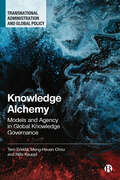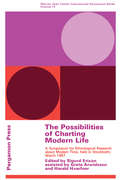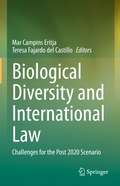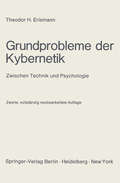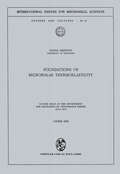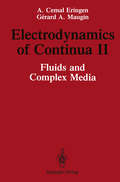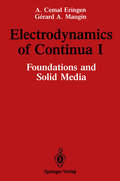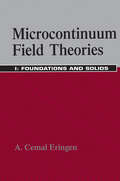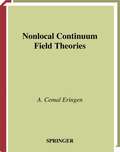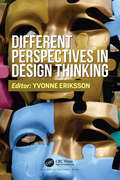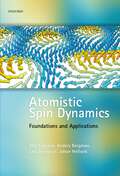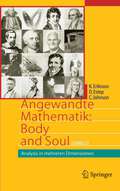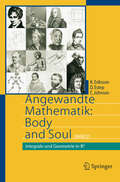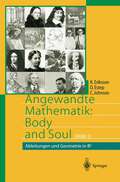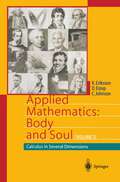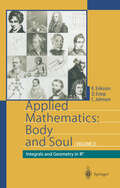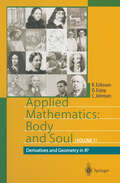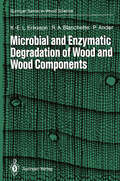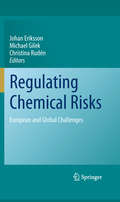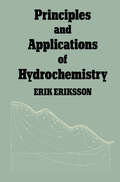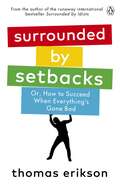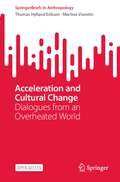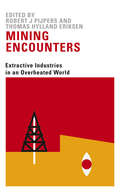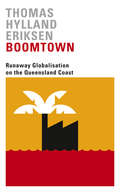- Table View
- List View
Knowledge Alchemy: Models and Agency in Global Knowledge Governance (Transnational Administration and Global Policy)
by Tero Erkkilä Meng-Hsuan Chou Niilo KauppiThis book introduces the concept of ‘knowledge alchemy’ to capture the generic process of transforming mundane practices and policies of governance into competitive ones following imagined global gold standards. Using examples from North America, Europe and Asia, it explores how knowledge alchemy increasingly informs national and institutional policies and practices on economic performance, higher education, research and innovation. The book examines how governments around the world have embraced global models of world-class university, human capital and talent competition as essential in ensuring national competitiveness. Through its analysis, the book shows how this strongly future-oriented and anticipatory knowledge governance is steered by a surge of global classifications, rankings and indicators, resulting in numerous comparisons of various domains that today form more constraining global policy scripts.
The Possibilities of Charting Modern Life: A Symposium for Ethnological Research About Modern Time in Stockholm, March 1967
by Sigurd ErixonWenner–Gren Center International Symposium Series, Volume 13: The Possibilities of Charting Modern Life presents the proceedings of the symposium on Anthropological Research on the Present, held in Stockholm, Sweden, on March 7–11, 1967. This book discusses the greater dependence of culture on central control and influences from outside. Organized into 13 chapters, this volume begins with an overview of the possibilities of applying the same methods for the study of the present as have been applied in the ethnology concentrated upon history. This text then clarifies the value of certain functional concepts in the light of the field material from the Tuareg culture. Other chapters consider the concept of applied ethnology, which is not historically oriented. This book discusses as well the gradual shifting of the concept of sex-role from its proper import of expression for the individual's biological statuses. This book is a valuable resource for social anthropologists.
Biological Diversity and International Law: Challenges for the Post 2020 Scenario
by Mar Campins Eritja Teresa Fajardo del CastilloThe book focuses on the interactions between international legal regimes related to biodiversity governance. It addresses the systemic challenges by analyzing the legal interactions between international biodiversity law and related international law applicable to economic activities, as well as issues related to the governance of biodiversity based on functional, normative, and geographic dimensions, in order to present a crosscutting, holistic approach. The global COVID-19 pandemic, the imminent revision of the Strategic Plan for Biodiversity 2011-2020, and the Aichi Targets have created the momentum to focus on the interactions between the Convention on Biological Diversity and other international environmental regimes. Firstly, it discusses the principles that inspire biodiversity-related conventional law, the soft law that conveys targets for enforcement of the Biodiversity Convention, their structural, regulatory and implementation gaps, the systemic relations arising from national interests, and the role of scientific advisory bodies in biodiversity-related agreements. The second part then addresses interactions in specific conventional frameworks, such as the law of multilateral trade and global public health, and the participation of communities in the management of genetic resources. Lastly, the third part illustrates these issues using four case studies focusing on the challenges for sustainability and marine biodiversity in small islands, the Arctic Ocean, the Caribbean Sea, and the Mediterranean Sea, as a way to strengthen a horizontal and joint approach. The book is primarily intended for academics, researchers, and students interested in international environmental law and policy and in interactions for creating conditions for fair, sustainable, and resilient environmental development. By offering an analysis of instruments and criteria for systemic relations in those areas, it will also appeal to public and private actors at the domestic and international level.
Grundprobleme der Kybernetik: Zwischen Technik und Psychologie
by Theodor H. Erismann2 Angesichts dieser Sachlage ist die Frage berechtigt, weshalb heute sch.on über die Grundfragen der Kybernetik geschrieben werden soll. Die Antwort ist einfach.: Das behandelte Gebiet ist von so eminenter Bedeutung, daß Versuche einer zusammenfassenden (wenn auch keineswegs erschöpfenden) Betrachtung in jeder Entwicklungsphase vollauf gerechtfertigt erscheinen. Es ist nicht sch.wer, den Nachweis für die Wich.tigkeit des Fragenkom plexes "Kybernetik" zu erbringen: Wir stehen an der Schwelle eines Wis senszweiges, der uns Aufschluß geben kann über die Funktionen des äußerst komplexen Apparates, welcher unsere höchsten Lebensfunktionen - und insbesondere das Denken - ermöglicht. Angesichts der großartigen Leistun gen, zu denen dieser Apparat befähigt ist, kann es dem Techniker nich.t gleichgültig sein, wie er organisiert ist. Es kann gar kein Zweifel darüber bestehen, daß eine vertiefte Kenntnis kybernetischer Zusammenhänge sich befruchtend auf analog gelagerte Gebiete der Technik auswirken muß. Geradezu schicksalhaftes Gewicht erhält die Auseinandersetzung mit der Kybernetik für den Psychologen. Sollte eine vollständige kybernetisch.-tech nische Durchleuchtung aller psychisch.en Vorgänge möglich werden, so sähe sich. die Psychologie über weite Strecken in den Rang einer Sekundärwissen sch.aft degradiert, die sich mit dem integralen Zusammenwirken von Einzel funktionen zu befassen hätte, deren Kenntnis die eigentliche und vielleich.t einzige Grundlage psychologischen Wissens wäre. Die Psychologie verhielte sich. dann zur Kybernetik ähnlich. wie etwa die Strömungslehre zur Mecha nik des Massenpunktes.
Foundations of Micropolar Thermoelasticity: Course held at the Department for Mechanics of Deformable Bodies July 1970 (CISM International Centre for Mechanical Sciences #23)
by Cemal EringenElectrodynamics of Continua II: Fluids and Complex Media
by A.Cemal Eringen Gerard A. MauginThis is the second volume of a two-volume set presenting a unified approach to the electrodynamics of continua, based on the principles of contemporary continuum of physics. The first volume was devoted mainly to the development of the theory and applications to deformable solid media. This volume extends the developments of the first volume to richer and newer grounds. It contains discussions on fluid media, magnetohydrodynamics, eletrohydrodynamics and media with more complicated structures. With the discussion, in the last two chapters, of memory-dependent materials and non-local E-M theory, the authors account for the nonlocal effects arising from motions and fields of material points at past times and at spatially distant points. This discussion is included here to stimulate further research in these important fields, which are presently in development stages. The second volume is self-contained and can be studied without the help of volume I. A section summarizing the constitutive equations and the underlying physical ideas, which were presented in more detail in the first volume, is included. This volume may be used as a basis for several graduate courses in engineering schools, applied mathematics and physics departments. It also contains fresh ideas and will stimulate further research in the directions the authors outline.
Electrodynamics of Continua I: Foundations and Solid Media
by A. Cemal Eringen Gerard A. MauginThe electrodynamics of continua is a branch ofthe physical sciences concerned with the interaction of electromagnetic fields with deformable bodies. De formable bodies are considered to be continua endowed with continuous distributions of mass and charge. The theory of electromagnetic continua is concerned with the determination of deformations, motions, stress, and elec tromagnetic fields developed in bodies upon the applications of external loads. External loads may be of mechanical origin (e.g., forces, couples, constraints placed on the surface of the body, and initial and boundary conditions arising from thermal and other changes) and/or electromagnetic origin (e.g., electric, magnetic, and current fields). Because bodies of different constitutions respond to external stimuli in a different way, it is imperative to characterize properly the response functions relevant to a given class of continua. This is done by means of the constitutive theory. For example, an elastic dielectric responds to electromagnetic fields in a totally different way than a magnetic fluid. The present book is intended to present a unified approach to the subject matter, based on the principles of contemporary continuum physics.
Microcontinuum Field Theories: I. Foundations and Solids
by A. Cemal EringenMicrocontinuum field theories extend classical field theories to microscopic spaces and short time scales. This volume is concerned with the kinematics of microcontinua. It begins with a discussion of strain, stress tensors, balance laws, and constitutive equations, and then discusses applications of the fundamental ideas to the theory of elasticity. The ideas developed here are important in modeling the fluid or elastic properties of porous media, polymers, liquid crystals, slurries, and composite materials.
Nonlocal Continuum Field Theories
by A. Cemal EringenNonlocal continuum field theories are concerned with material bodies whose behavior at any interior point depends on the state of all other points in the body -- rather than only on an effective field resulting from these points -- in addition to its own state and the state of some calculable external field. Nonlocal field theory extends classical field theory by describing the responses of points within the medium by functionals rather than functions (the "constitutive relations" of classical field theory). Such considerations are already well known in solid-state physics, where the nonlocal interactions between the atoms are prevalent in determining the properties of the material. The tools developed for crystalline materials, however, do not lend themselves to analyzing amorphous materials, or materials in which imperfections are a major part of the structure. Nonlocal continuum theories, by contrast, can describe these materials faithfully at scales down to the lattice parameter. This book presents a unified approach to field theories for elastic solids, viscous fluids, and heat-conducting electromagnetic solids and fluids that include nonlocal effects in both space and time (memory effects). The solutions to the field equations agree remarkably well with atomic theories and experimental observations.
Different Perspectives in Design Thinking
by Yvonne ErikssonGlobalization and digitalization are buzz words in contemporary society. They affect both our private and our professional lives. Society has become more diverse with easier access to information and to virtual platforms that gives us opportunity to be in touch with colleagues, friends, family, etc. at any time. A complex environment is emerging wherein internet of things and big data are being integrated with products, production systems, healthcare, and daily activity and play an important part in decision making. This has an impact on future designs and the role of designers. Responsible designers with a holistic perspective are needed.The book highlights several aspects of design thinking such as Information Design and Critical Design. The meaning of culture, gender and disabilities are also discussed. The functions of Information Design are changing from ‘showing the way’, instruction manuals and graphic design. It will affect among others, healthcare technology, smart products and Industry 4.0. Design thinking perspective that includes users from the entire chain and from the producer to the end user of the product or service, is needed. This will also require gender and culture issues to be taken into consideration in designing products and services. Design thinking methods and critical aspects of design will contribute to an inclusive society.
Different Perspectives in Design Thinking
by Yvonne ErikssonGlobalization and digitalization are buzz words in contemporary society. They affect both our private and our professional lives. Society has become more diverse with easier access to information and to virtual platforms that gives us opportunity to be in touch with colleagues, friends, family, etc. at any time. A complex environment is emerging wherein internet of things and big data are being integrated with products, production systems, healthcare, and daily activity and play an important part in decision making. This has an impact on future designs and the role of designers. Responsible designers with a holistic perspective are needed.The book highlights several aspects of design thinking such as Information Design and Critical Design. The meaning of culture, gender and disabilities are also discussed. The functions of Information Design are changing from ‘showing the way’, instruction manuals and graphic design. It will affect among others, healthcare technology, smart products and Industry 4.0. Design thinking perspective that includes users from the entire chain and from the producer to the end user of the product or service, is needed. This will also require gender and culture issues to be taken into consideration in designing products and services. Design thinking methods and critical aspects of design will contribute to an inclusive society.
Atomistic Spin Dynamics: Foundations and Applications
by Olle Eriksson Anders Bergman Lars Bergqvist Johan HellsvikThe purpose of this book is to provide a theoretical foundation and an understanding of atomistic spin-dynamics (ASD), and to give examples of where the atomistic Landau-Lifshitz-Gilbert equation can and should be used. As argued in the text, a description of magnetism in an atomistic way is very natural and allows for an interpretation of experimental results in a clear and deep way. This description also allows for calculations, from first principles, of all parameters needed to perform the spin-dynamics simulations, without using experimental results as input to the simulations. As shown in the book, we are now at a very exciting situation, where it is possible to perform accurate and efficient atomistic simulations on a length- and time-scale which is balancing on the edge of what is experimentally possible. In this way, ASD simulations can both validate and be validated by state-of-the art experiments, and ASD simulations also have the possibility to act as a predictive tool that is able to explain the magnetization dynamics in experimentally inaccessible situations. The purpose of this book has been to communicate technically relevant concepts. An even larger motivation is to communicate an inspiration to magnetism and magnetization dynamics, and the emerging technological fields that one may foresee, e.g. in magnonics, solitonics and skyrmionics.
Angewandte Mathematik: Band 3: Analysis in mehreren Dimensionen
by Kenneth Eriksson Donald Estep Claes JohnsonAngewandte Mathematik: Body and Soul ist ein neuer Grundkurs in der Mathematikausbildung für Studienanfänger in den Naturwissenschaften, der Technik, und der Mathematik, der an der Chalmers Tekniska Högskola in Göteborg entwickelt wurde. Er besteht aus drei Bänden sowie Computer-Software. Das Projekt ist begründet in der Computerrevolution, die ihrerseits völlig neue Möglichkeiten des wissenschaftlichen Rechnens in der Mathematik, den Naturwissenschaften und im Ingenieurwesen eröffnet hat. Es besteht aus einer Synthese der mathematischen Analysis (Soul) mit der numerischen Berechnung (Body) sowie den Anwendungen. Die Bände I-III geben eine moderne Version der Analysis und der linearen Algebra wieder, einschließlich konstruktiver numerischer Techniken und Anwendungen, zugeschnitten auf Anfängervorlesungen im Maschinenbau und den Naturwissenschaften. Dieser Band behandelt die Analysis in mehreren Variablen, einschließlich partieller Ableitungen, mehr-dimensionaler Integrale, partieller Differentialgleichungen und finiter Elemente-Methode, zusammen mit einer Auswahl von Anwendungen für Systeme partieller Differentialgleichungen.Die Autoren sind führende Experten im Gebiet des wissenschaftlichen Rechnens und haben schon mehrere erfolgreiche Bücher geschrieben."[......] Oh, by the way, I suggest immediate purchase of all three volumes!"
Angewandte Mathematik: Band 2: Integrale und Geometrie in IRn
by Kenneth Eriksson Donald Estep Claes Johnson"Angewandte Mathematik: Body & Soul" ist ein neuer Grundkurs in der Mathematikausbildung für Studienanfänger in den Naturwissenschaften, der Technik, und der Mathematik, der an der Chalmers Tekniska Högskola in Göteborg entwickelt wurde. Er besteht aus drei Bänden sowie Computer-Software. Das Projekt ist begründet in der Computerrevolution, die ihrerseits völlig neue Möglichkeiten des wissenschaftlichen Rechnens in der Mathematik, den Naturwissenschaften und im Ingenieurwesen eröffnet hat. Es besteht aus einer Synthese der mathematischen Analysis (Soul) mit der numerischen Berechnung (Body) sowie den Anwendungen. Die Bände I-III geben eine moderne Version der Analysis und der linearen Algebra wieder, einschließlich konstruktiver numerischer Techniken und Anwendungen, zugeschnitten auf Anfängerprogramme im Maschinenbau und den Naturwissenschaften. Weitere Bände behandeln Themen wie z.B. dynamische Systeme, Strömungsdynamik, Festkörpermechanik und Elektromagnetismus. Dieser Band entwickelt das Riemann-Integral, um eine Funktion zu einer gegebenen Ableitung zu bestimmen. Darauf aufbauend werden Differentialgleichungen und Anfangswertprobleme mit einer Vielzahl anschaulicher Anwendungen behandelt. Die lineare Algebra wird auf n-dimensionale Räume verallgemeinert, wobei wiederum dem praktischen Umgang und numerischen Lösungstechniken besonderer Platz eingeräumt wird. Die Autoren sind führende Experten im Gebiet des wissenschaftlichen Rechnens und haben schon mehrere erfolgreiche Bücher geschrieben. "[......] Oh, by the way, I suggest immediate purchase of all three volumes!" The Mathematical Association of America Online, 7.7.04
Angewandte Mathematik: Band 1: Ableitungen und Geometrie in IR3
by Kenneth Eriksson Donald Estep Claes JohnsonApplied Mathematics: Calculus in Several Dimensions
by Kenneth Eriksson Donald Estep Claes JohnsonApplied Mathematics: Body & Soul is a mathematics education reform project developed at Chalmers University of Technology and includes a series of volumes and software. The program is motivated by the computer revolution opening new possibilitites of computational mathematical modeling in mathematics, science and engineering. It consists of a synthesis of Mathematical Analysis (Soul), Numerical Computation (Body) and Application. Volumes I-III present a modern version of Calculus and Linear Algebra, including constructive/numerical techniques and applications intended for undergraduate programs in engineering and science. Further volumes present topics such as Dynamical Systems, Fluid Dynamics, Solid Mechanics and Electro-Magnetics on an advanced undergraduate/graduate level. The authors are leading researchers in Computational Mathematics who have written various successful books.
Applied Mathematics: Volume 2: Integrals and Geometry in IRn
by Kenneth Eriksson Donald Estep Claes JohnsonApplied Mathematics: Body & Soul is a mathematics education reform project developed at Chalmers University of Technology and includes a series of volumes and software. The program is motivated by the computer revolution opening new possibilities of computational mathematical modeling in mathematics, science and engineering. It consists of a synthesis of Mathematical Analysis (Soul), Numerical Computation (Body) and Application. Volumes I-III present a modern version of Calculus and Linear Algebra, including constructive/numerical techniques and applications intended for undergraduate programs in engineering and science. Further volumes present topics such as Dynamical Systems, Fluid Dynamics, Solid Mechanics and Electro-Magnetics on an advanced undergraduate/graduate level. The authors are leading researchers in Computational Mathematics who have written various successful books.
Applied Mathematics: Volume 1: Derivatives and Geometry in IR3
by Kenneth Eriksson Donald Estep Claes JohnsonApplied Mathematics: Body & Soul is a mathematics education reform project developed at Chalmers University of Technology and includes a series of volumes and software. The program is motivated by the computer revolution opening new possibilitites of computational mathematical modeling in mathematics, science and engineering. It consists of a synthesis of Mathematical Analysis (Soul), Numerical Computation (Body) and Application. Volumes I-III present a modern version of Calculus and Linear Algebra, including constructive/numerical techniques and applications intended for undergraduate programs in engineering and science. Further volumes present topics such as Dynamical Systems, Fluid Dynamics, Solid Mechanics and Electro-Magnetics on an advanced undergraduate/graduate level. The authors are leading researchers in Computational Mathematics who have written various successful books.
Microbial and Enzymatic Degradation of Wood and Wood Components (Springer Series in Wood Science)
by Karl-Erik L. Eriksson Robert A. Blanchette Paul AnderThe oil crisis during the 1970s turned interest towards the utilization of renewable resources and towards lignocellulosics in particular. The 1970s were also the cradle period of biotechnology, and the years when biotechnical utilization of lignocellulosic waste from agriculture and forestry gained priori ty. This was a logical conclusion since one of nature's most important biologi cal reactions is the conversion of wood and other lignocellulosic materials to carbon dioxide, water and humic substances. However, while biotechnology in other areas like medicine and pharmacology concerned production of expen sive products on a small scale, biotechnical utilization and conversion of ligno cellulosics meant production of inexpensive products on a large scale. Biotechnical utilization of lignocellulosic materials is therefore a very difficult task, and the commercial utilization of this technology has not progressed as rapidly as one would have desired. One reason for this was the lack of basic knowledge of enzyme mechanisms involved in the degradation and conversion of wood, other lignocellulosics and their individual components. There are also risks associated with initiating a technical development before a stable platform of knowledge is available. Several of the projects started with en thusiasm have therefore suffered some loss of interest. Also contributing to this failing interest is the fact that the oil crisis at the time was not a real one. At present, nobody predicts a rapid exhaustion of the oil resources and fuel production from lignocellulosics is no longer a high priority.
Regulating Chemical Risks: European and Global Challenges
by Johan Eriksson Michael Gilek Christina RudénThis volume presents research on current trends in chemical regulations – a fa- growing, complex, and increasingly internationalized field. The book grew out from a multidisciplinary research project entitled ‘Regulating Chemical Risks in the Baltic Sea Area: Science, Politics, and the Media’, led by Michael Gilek at Södertörn University, Sweden. This research project involved scholars and experts from natural as well as social sciences, based at Södertörn University, Swedish Royal Institute of Technology (KTH), Karolinska Institutet, and Umeå University. The project group organized a multidisciplinary research conference on chemical risk regulations, held in Stockholm, August 15–17, 2007. Most of the contributions published in this book were, in draft form, first presented at this conference. The conference, like the ensuing edited volume, expanded the geographical focus beyond the Baltic Sea area to include wider European, and to some extent also global trends. Many thanks to all project colleagues and conference participants! We are very grateful for the generous financial support received from The Foundation for Baltic and East European Studies (Östersjöstiftelsen), The Swedish Research Council Formas, and from Södertörn University. Without this support the present book would not have been possible. Special thanks to all of our fellow contributors, all of whom have submitted to- cal papers based on high-quality research. Many thanks also to Tobias Evers, who assisted us with technical editing. Finally, we are grateful for the professionalism shown by our editors at Springer.
Principles and Applications of Hydrochemistry
by Erik ErikssonThe International Hydrological Decade (which ended in 1975) led to a revival of hydrological sciences to a degree which, seen in retrospect, is quite spectacular. This research programme had strong government support, no doubt due to an increased awareness of the role of water for prosperous development. Since water quality is an essential ingredient in almost all water use, there was also a considerable interest in hydrochemistry during the Decade. As many concepts in classical hydrology had to be revised during and after the Decade there was also a need for revising hydrochemistry to align it with modern hydrology. A considerable input of fresh knowledge was also made in the recent past by chemists, particularly geochemists, invaluable for understanding the processes of mineralization of natural waters. With all this in mind it seems natural to try to assemble all the present knowledge of hydrochemistry into a book and integrate it with modern hydrology as far as possible, emphasizing the dynamic features of dissolved substances in natural waters. Considering the role of water in nature for transfer of substances, this integration is essential for proper understanding of processes in all related earth sciences. The arrangement of subjects in the book is as follows. After a short introductory chapter comes a chapter on elementary chemical principles of particular use in hydrochemistry.
Surrounded by Setbacks: Or, How to Succeed When Everything's Gone Bad
by Thomas EriksonHow to handle everything (and everyone) around you when all hell breaks loose, from the international bestselling author of Surrounded by Idiots.Not everything goes the way we want it to - the world or people around us sometimes just spin out of control. Just consider the Covid pandemic for starters. Or how about that mad neighbour you have living next-door to you? Or when work seems to be going down the toilet when the competition keep outsmarting you? So how do you handle everything life throws your way when you'd really prefer to tell everyone to get stuffed?Thomas Erikson will help you turn adversity into success with the help of the behavioural model made famous in Surrounded by Idiots. Starting by reminding us that life is as it is, Erikson helps you see that it is in fact useless to try to control everything happening around you. Instead of protesting when life throws you curveballs, focus instead on how to handle them. Just as you keep the weeds away from the garden to provide space and amazing flowers, you need to find an approach to adversity that works for you and will give you the chance to turn everything into success. Surrounded by Setbacks will help you pinpoint the approach that works for you and will entertain and empower you in equal measure.
Acceleration and Cultural Change: Dialogues from an Overheated World (SpringerBriefs in Anthropology)
by Thomas Hylland Eriksen Martina VisentinThis open access book includes socio-anthropological and anthropo-sociological conversations between one of the world’s leading anthropologists, Thomas Hyland Eriksen, and a young scholar, using his groundbreaking "overheating" approach.This book includes socio-anthropological and anthropo-sociological conversations between one of the world’s leading anthropologists, Thomas Hyland Eriksen, and a young scholar, using his groundbreaking "overheating" approach. From the pandemic to the spread of nationalism, from the Anthropocene to the Homogenocene, the authors discuss the most urgent issues of current society: e.g., the loss of biological and cultural diversity owing to the forces of globalisation; and the emergence of new forms of diversity through globalisation and migration; the intersectional dimension of climate change; the incredible rising of anger demonstrations around the world and resentful, overheated identities often linked to right-wing nationalism; the way digital devices have changed the meaning of temporality in people's life-worlds; the regulatory and competitive pressures on universities which are a result of many factors in the intersection of globalisation, massification and marketisation; youth's weakened belief in progress connected to changes in the contemporary world, such as growing inequality, political alienation and environmental destruction; recent pathbreaking research and original theory in sociology and anthropology related to the changes in an overheated world; and what post-Coronavirus social life might become. Highly topical, engaging and written in a conversational style, this book is a must-read for social scientists and discerning lay persons who want a fresh perspective on understanding the critical issues of our time. This is an open access book.
Mining Encounters: Extractive Industries in an Overheated World
by Thomas Hylland Eriksen Robert Jan PijpersIn a fast-changing world, where the extraction of natural resources is key to development, whilst also creating environmental and social disasters, understanding how landscapes, people and politics are shaped by extraction is crucial.*BR**BR*Looking at resource extraction in numerous locations at different stages of development, including North, West and South Africa, India, Kazakhstan and Australia, a broad picture is created, covering coal, natural-gas, gold and cement mining, from corporate to 'artisanal' extraction, from the large to the small scale. The chapters answer the questions: What is ideological about resource extraction? How does extraction transform the physical landscape? And how does the extractive process determine which stakeholders become dominant or marginalised?*BR**BR*Contributing to policy debates, Mining Encounters uncovers the tensions, negotiations and disparities between different actors in the extractive industries, including exploiters and those who benefit or are impoverished by resource exploitation.
Boomtown: Runaway Globalisation on the Queensland Coast
by Thomas Hylland EriksenSitting next to the Great Barrier Reef, marinated in coal and gas, the industrial boomtown of Gladstone, Australia embodies many of the contradictions of the 'overheated' world: prosperous yet polluted; growing and developing yet always on the precipice of uncertainty.*BR**BR*Capturing Gladstone at the peak of its accelerated growth in 2013-14, Thomas Hylland Eriksen dissects the boomtown phenomenon in all its profound ambivalence. Based on ethnographic fieldwork, the book explores the tensions and resentments surrounding migrant workers, and examines local identity, family life, infrastructure and local services.*BR**BR*Writ large in Boomtown are the clashes of scale at the heart of the town's contradictions - where the logic of big industry and the state compete with that of the individual, local communities and ecology, revealing the current crisis of political legitimacy across the world.
